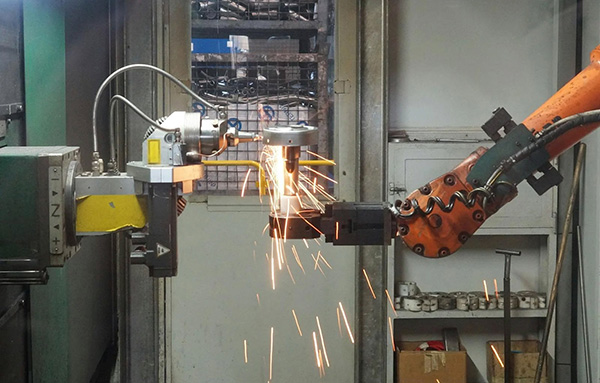This article explores how US manufacturers can regain global competitiveness using robotics, and how the government can facilitate a rebirth.
The worldwide economy has changed enormously over the past 100 years. Today, the intensifying trade war is dominating headlines – each day sending a new jolt of uncertainty for economists and consumers alike. The latest “fix” is supposed to be built off trade deficits, tariffs, and other immediate changes that will strong-arm our problems away. But in reality, the problem requires a larger step back and longer-term plan. America has slowly drifted away from brick-and-mortar manufacturing, but we can and must restore it by utilizing the thing we have that no one else does: our advanced robotics and automation power, and the subsequent capability we have to create a robotics-based manufacturing boom. By combining our long history of building and doing with the creative, technology-oriented talent we’ve fostered for the past three decades, America has the chance to harken back to our days of manufacturing glory with this new blueprint.
This can only be done if we accept our difficulties in certain areas. In today’s global economy, we’re never going to win the labor arbitrage battle. Things are different than they were in the post-war era. America has many of the brightest, most innovative minds in the world, and we need to let them unleash their abilities in the way that counts. The way to put genius to work is by incentivizing innovation and helping businesses employ robotics automation in exciting new ways to bring the future of manufacturing to life.
From the 1950s to the late 70s, we churned out 40% of the world’s goods, powered by assembly lines and a working middle class that could afford the American Dream. R&D was our secret weapon – Bell Labs gave us transistors; Boeing gave us the 707. Government incentives, grants, corporate labs, and a flood of GI Bill-educated workers kept the ideas flowing and the factories humming.
Then, something shifted. By the 1980s, we swapped our blue collars for white ones, and U.S. manufacturing’s share of GDP slid from 28% in 1953 to 10.7% by 2024. Japan, Germany, and China all outbuilt us while we focused on a service and investment-based economy. Today, the urgent need to revitalize manufacturing reflects broader economic, geopolitical, and social imperatives: reducing supply chain vulnerabilities and countering China’s manufacturing dominance.
The saving grace is that modern industry has evolved significantly, transformed by AI, automation, and other highly evolved, ultra-specific technologies. Robotics and generative AI once again provide an opportunity to level the playing field – but only if those technologies are invested in and promoted. Instead of trying to return to our post-war manufacturing boom, we should instead plant new seeds, focusing on these tech-fueled possibilities.

Over 65% of supply chain workers say reshoring costs are rising. Such a critical issue cannot be solved by one, single myopic solution. Though tariffs seem like an appealing fix – theoretically bringing back jobs and protecting our blue-chip industries – the results are mixed.
Today, while American companies spend $850 billion on R&D – the most in the world – only 30% goes to manufacturing tech. Compare this to China’s trailblazing path into the future. China just leapfrogged the rest of the world in robot density, the benchmark metric used to compare the level of automation in manufacturing and industrial sectors. Incredibly, China has now surpassed even Germany and Japan, leading the world with 470 robots per 10,000 employees. Meanwhile, the U.S. is light-years away, still stuck behind countries like Slovenia and Sweden.
This one stat gives a telling glimpse into how unprepared America’s manufacturing sector is for the future. Even further, China’s adoption of robotics far outpaces any other country, with 290,000 robotic installations per year. That is 7X the United States’ annual installation rate, and it demonstrates the speed at which the manufacturing future is coming.
China’s rise is supported by strategic policies and global investments, cementing its role as the world’s largest and fastest-growing robotics market. Part of China’s robotics dominance is due to extremely favorable R&D tax policies that allow for 200% deduction from R&D spending. Conversely, American companies are hamstrung by Section 174, forced to spread deductions over six long years. Unsurprisingly, 65% of small manufacturers are cutting R&D.
American lawmakers must act to stem the tide. Of the many potential remedies, the U.S. can fix 174, improve domestic manufacturing credits, invest in education and university grants for robotics research, and facilitate new robotics installations for manufacturers.
While Chinese companies enjoy a more favorable atmosphere for innovation, manufacturers in America still have incentives available to them to help subsidize the costs of R&D. The Section 174 deduction is substantially weaker than the Chinese counterpart, but there is a strong indication that the upcoming tax bill will restore the deduction to 100%.
Separately, the tax code also provides for an R&D Credit to go alongside the deduction. The credit can often be a six-figure refund for manufacturing businesses and is based on the labor and material costs connected with their day-to-day work. Anything a manufacturer does to create new or improve existing products or processes can potentially qualify.
While many manufacturers are already taking advantage of the credit, the law has changed dramatically over the years, and oftentimes businesses end up underclaiming what is available to them.
The manufacturing industry has evolved a long way from punch cards to AI, and the future doesn’t rely on tariffs, but on out-innovating everyone else. While there continues to be a level of uncertainty as there are new economic shifts and implications every week, the smartest manufacturers are already there – using AI to streamline production, robotics to cut costs and improve safety, and meaningful incentives to fund it all. They’re not reshoring out of a deeper sense of duty–but because tech makes it viable. By doubling down on R&D, embracing Industry 4.0 technologies, and repealing barriers like Section 174, the U.S. can reclaim its industrial edge.
About the Authors:

Dhaval Jadav is the co-founder and CEO of alliant. Under Jadav’s leadership, the firm has empowered 24,000+ companies in 70+ industries with actionable business solutions. Prior to founding alliant, Jadav developed his expertise in high-tech business deals as a member of a Mergers & Acquisitions/Private Equity/Strategic Buyer Services Group in San Francisco and honed his business operations acumen with Deloitte & Touche in its Washington National Office.

Myron Moser is a Strategic Advisory Board Member at alliant, in addition to Chairman Emeritus of Hartfiel Automation in Minnesota. He joined Hartfiel Automation in 1990 and quickly rose in the ranks to the executive level in 1995. Myron is recognized as one of the top executives in the U.S. automation industry. Under his leadership, Hartfiel Automation experienced incredible growth, continued to diversify its product offerings in hydraulics, aluminum extrusions, and robotics and automation solutions. For more than 60 years, his company helped strengthen the American manufacturing industry through innovative solutions. Myron leverages his decades of experience as a top executive in the world of automation for strategic benefit of alliant’s clients and CPA partners.
Read more from the authors:
Robotics is About People – Why You Need Change Management | Robotics Tomorrow, April 21, 2025
Can AI agents change the world without AGI? | TechRadar, April 3, 2025
The Tariff Remedy Manufacturers Aren’t Talking About | Manufacturing.net, April 1, 2025
References –
https://prosperousamerica.org/u-s-manufacturings-shrinking-share-of-gdp-and-how-to-catch-up/
https://taxfoundation.org/research/all/federal/trump-tariffs-trade-war/
https://www.cnbc.com/2025/04/14/tariffs-wont-bring-manufacturing-back-to-us-supply-chain-survey.html
https://taxfoundation.org/blog/us-china-competition-technology-rd-tax-treatment/
In this episode, I sat down with Beejan Giga, Director | Partner and Caleb Emerson, Senior Results Manager at Carpedia International. We discussed the insights behind their recent Industry Today article, “Thinking Three Moves Ahead” and together we explored how manufacturers can plan more strategically, align with their suppliers, and build the operational discipline needed to support intentional, sustainable growth. It was a conversation packed with practical perspectives on navigating a fast-changing industry landscape.